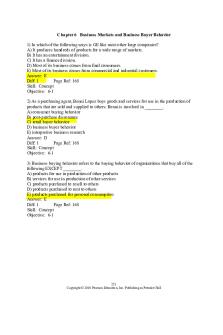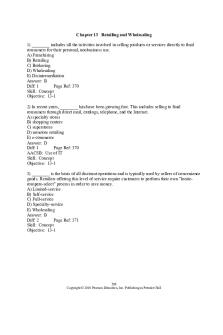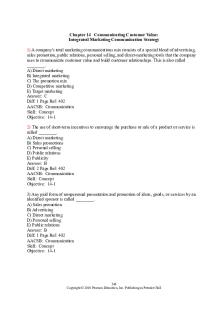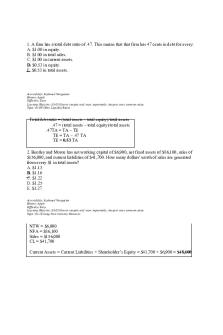Kotler Chapter 11 MCQ - Multiple choice questions with answers PDF

| Title | Kotler Chapter 11 MCQ - Multiple choice questions with answers |
|---|---|
| Course | Principles of Marketing |
| Institution | The University of the West Indies Mona |
| Pages | 41 |
| File Size | 247.1 KB |
| File Type | |
| Total Downloads | 547 |
| Total Views | 682 |
Summary
Chapter 11 Pricing Strategies A company sets not a single price, but rather a ________ that covers different items in its line that change over time as products move through their life cycles. A) pricing by-product B) pricing structure C) pricing loop D) pricing cycle E) pricing bundle Answer: B Dif...
Description
Chapter 11 Pricing Strategies 1) A company sets not a single price, but rather a ________ that covers different items in its line that change over time as products move through their life cycles. A) pricing by-product B) pricing structure C) pricing loop D) pricing cycle E) pricing bundle Answer: B Diff: 1 Page Ref: 311 Skill: Concept Objective: 11-1 2) Companies facing the challenge of setting prices for the first time can choose between two broad strategies: market-penetration pricing and ________. A) market-level pricing B) market-competitive pricing C) market-skimming pricing D) market-price lining E) market-price filling Answer: C Diff: 2 Page Ref: 312 Skill: Concept Objective: 11-1 3) Of the following, which statement would NOT support a market-skimming policy for a new product? A) The product's quality and image support its higher price. B) Enough buyers want the products at that price. C) Competitors are not able to undercut the high price. D) Competitors can enter the market easily. E) C and D Answer: D Diff: 3 Page Ref: 312 Skill: Concept Objective: 11-1
426 Copyright © 2010 Pearson Education, Inc. Publishing as Prentice Hall
4) A firm is using ________ when it charges a high, premium price for a new product with the intention of reducing the price in the future. A) price skimming B) trial pricing C) value pricing D) market-penetration pricing E) prestige pricing Answer: A Diff: 2 Page Ref: 312 Skill: Concept Objective: 11-1 5) ________ pricing is the approach of setting a low initial price in order to attract a large number of buyers quickly and win a large market share. A) Market-skimming B) Market-penetration C) Below-market D) Value-based E) Leader Answer: B Diff: 1 Page Ref: 313 Skill: Concept Objective: 11-1 6) Accent Software faces the conditions below, all of which support Accent's use of a marketpenetration pricing strategy EXCEPT that ________. A) the market is highly price sensitive B) production and distribution costs will fall as sales volume increases C) the product's quality and image support a high price D) a low price would help keep out the competition E) A and C Answer: C Diff: 3 Page Ref: 313 Skill: Concept Objective: 11-1
427 Copyright © 2010 Pearson Education, Inc. Publishing as Prentice Hall
7) Which of the following is a reason that a marketer would choose a penetration pricing strategy? A) to ensure the company has the ability to increase prices once demand decreases B) to focus on the rapid achievement of profit objectives C) to appeal to different consumer segments with different levels of price sensitivity D) to create markets for highly technical products E) to discourage competition from entering the market Answer: E Diff: 3 Page Ref: 313 Skill: Concept Objective: 11-1 8) Companies usually develop ________ rather than single products. A) product families B) product lines C) product groupings D) product brands E) product images Answer: B Diff: 1 Page Ref: 313 Skill: Concept Objective: 11-2 9) A marketer must be familiar with the five major product mix pricing situations. Which of the following is NOT one of them? A) product line pricing B) optional-product pricing C) captive-product pricing D) unbundled product pricing E) by-product pricing Answer: D Diff: 3 Page Ref: 313 Skill: Concept Objective: 11-2 10) A challenge for management in product line pricing is to decide on the price steps between the ________. A) various products in a line B) product mixes C) product groupings D) product lines E) various target markets Answer: A Diff: 2 Page Ref: 313 Skill: Concept Objective: 11-2
428 Copyright © 2010 Pearson Education, Inc. Publishing as Prentice Hall
11) When using price steps, the seller must establish perceived ________ that support the price differences. A) nonprice competitions B) quality differences C) quantity levels D) images E) strategies Answer: B Diff: 2 Page Ref: 314 AACSB: Communication Skill: Concept Objective: 11-2 12) Many producers who use captive-product pricing set the price of the main product ________ and set ________ on the supplies necessary to use the product. A) low; low markups B) high; low markups C) low; high markups D) high; high markups E) moderately; moderate markups Answer: C Diff: 2 Page Ref: 314 Skill: Concept Objective: 11-2 13) When amusement parks and movie theaters charge admission plus fees for food and other attractions, they are following a(n) ________ pricing strategy. A) by-product B) optional-product C) captive-product D) skimming E) penetration Answer: C Diff: 2 Page Ref: 315 Skill: Concept Objective: 11-2
429 Copyright © 2010 Pearson Education, Inc. Publishing as Prentice Hall
14) HiPoint Telephone Company uses two-part pricing for its long-distance call charges. Because this is a service, the price is broken into a fixed rate plus a ________. A) fixed rate usage B) variable usage rate C) standard usage rate D) market usage rate E) none of the above Answer: B Diff: 1 Page Ref: 315 Skill: Concept Objective: 11-2 15) Companies involved in deciding which items to include in the base price and which to offer as options are engaged in ________ pricing. A) product bundle B) optional-product C) captive-product D) by-product E) skimming Answer: B Diff: 1 Page Ref: 314 Skill: Concept Objective: 11-2 16) Keeping in mind that a seller must sell by-products at a price that covers more than the cost of storing and delivering them, which of the following will by-product pricing permit a seller to do? A) increase the main product's price B) make extra profit C) reduce the main product's price D) none of the above E) B and C Answer: E Diff: 3 Page Ref: 315 Skill: Concept Objective: 11-2
430 Copyright © 2010 Pearson Education, Inc. Publishing as Prentice Hall
17) With product bundle pricing, sellers can combine several products and offer the bundle ________. A) as a working unit B) at a reduced price C) as a complete self-service package D) as a reward to loyal customers E) as segmented pricing Answer: B Diff: 1 Page Ref: 315 Skill: Concept Objective: 11-2 18) What is a major advantage of product bundle pricing? A) It can promote the sales of products consumers might not otherwise buy. B) It offers consumers more value for the money. C) It combines the benefits of the other pricing strategies. D) It provides a more complete product experience for consumers. E) All of the above. Answer: A Diff: 2 Page Ref: 315 Skill: Concept Objective: 11-2 19) Which of the following is NOT a price adjustment strategy? A) segmented pricing B) promotional pricing C) free samples D) geographical pricing E) seasonal pricing Answer: C Diff: 2 Page Ref: 315 Skill: Concept Objective: 11-3 20) Service Industries, Inc., plans to offer a price-adjustment strategy in the near future. They could consider each of the following EXCEPT ________. A) discount and allowance pricing B) segmented pricing C) physiological pricing D) promotional pricing E) location pricing Answer: C Diff: 2 Page Ref: 315 Skill: Concept Objective: 11-3
431 Copyright © 2010 Pearson Education, Inc. Publishing as Prentice Hall
21) A quantity discount is a price reduction to buyers who purchase ________. A) frequently B) large volumes C) close outs D) inferior merchandise E) superior merchandise Answer: B Diff: 2 Page Ref: 316 Skill: Concept Objective: 11-3 22) Trade or functional discounts are offered by manufacturers to which of the following? A) channel members who perform tasks that the manufacturer would otherwise have to perform B) consumers who earn a price reduction for buying in bulk C) intermediaries such as financing institutions as a cost of doing business with them D) manufacturers that agree to exclusive distribution contracts E) the government market and other organizations that require bid proposals Answer: A Diff: 3 Page Ref: 316 Skill: Concept Objective: 11-3 23) Which of the following is an example of a cash discount? A) 2/10, net 30 B) $5.00 with a two-pack C) a free case when you buy 12 D) when you pay cash and take the product with you E) none of the above Answer: A Diff: 3 Page Ref: 316 Skill: Concept Objective: 11-3 24) When General Motors provides payments or price reductions to its new car dealers as rewards for participating in advertising and sales support programs, it is granting a(n) ________. A) trade discount B) functional discount C) allowance D) promotional allowance E) trade credit Answer: D Diff: 1 Page Ref: 316 Skill: Concept Objective: 11-3
432 Copyright © 2010 Pearson Education, Inc. Publishing as Prentice Hall
25) Quantity discounts provide an incentive to the customer to buy ________. A) more products or services from a variety of sellers B) less from another competitor C) more from one given seller, rather than from many different sources D) more than he or she needs E) bundled merchandise Answer: C Diff: 2 Page Ref: 316 Skill: Concept Objective: 11-3 26) By definition, this type of pricing is used when a firm sells a product or service at two or more prices, even though the difference in price is not based on differences in cost. A) segmented pricing B) variable pricing C) flexible pricing D) cost-plus pricing E) reference pricing Answer: A Diff: 2 Page Ref: 316 Skill: Concept Objective: 11-2 27) When a firm varies its price by the season, month, day, or even hour, it is using ________ pricing. A) revenue management B) penetration C) variable D) time E) value-added Answer: D Diff: 1 Page Ref: 316 Skill: Concept Objective: 11-3 28) Airlines, hotels, and restaurants call segmented pricing ________. A) time pricing B) yield management C) location pricing D) segmented E) service pricing Answer: B Diff: 2 Page Ref: 317 Skill: Concept Objective: 11-3
433 Copyright © 2010 Pearson Education, Inc. Publishing as Prentice Hall
29) Which of the following conditions should exist for segmented pricing to be an effective strategy? A) The market must be able to be segmented. B) The segments must show different degrees of demand. C) Competitors can't undersell in the segment being charged the higher price. D) All of the above. E) None of the above. Answer: D Diff: 2 Page Ref: 317 Skill: Concept Objective: 11-3 30) Consumers usually perceive higher-priced products as ________. A) not within reach of most people B) having a higher quality C) having high profit margins D) popular brands E) being in the introductory stage of the product life cycle Answer: B Diff: 2 Page Ref: 317 Skill: Concept Objective: 11-3 31) Consumer use price less to judge the quality of a product when they ________. A) lack information B) lack skills to use the product C) have experience with the product D) are shopping for a specialty item E) cannot physically examine the product Answer: C Diff: 2 Page Ref: 317 Skill: Concept Objective: 11-3 32) Michael and John both own leather jackets and are currently shopping for two new ones. They both have prices in mind and refer to them when shopping. These prices are termed ________. A) psychological prices B) reference prices C) comparison prices D) price points E) skimmed prices Answer: B Diff: 2 Page Ref: 319 Skill: Concept Objective: 11-3
434 Copyright © 2010 Pearson Education, Inc. Publishing as Prentice Hall
33) Which of the following refers to the prices that a buyer carries in his or her mind and refers to when looking at a given product? A) target prices B) reference prices C) promotional prices D) geographical prices E) dynamic prices Answer: B Diff: 1 Page Ref: 319 Skill: Concept Objective: 11-3 34) When consumers cannot judge quality because they lack the information or skill, price becomes ________. A) less important B) insignificant C) an important quality signal D) the only driver of the purchase E) none of the above Answer: C Diff: 2 Page Ref: 317 Skill: Concept Objective: 11-3 35) All of the following are typical ways a reference price might be formed in a buyer's mind EXCEPT ________. A) noting current prices B) remembering past prices C) assessing the buying situation D) comparing it to a new product E) influences from sellers Answer: D Diff: 2 Page Ref: 319 Skill: Concept Objective: 11-3 36) What type of pricing is being used when a company temporarily prices it product below the list price or even below cost to create buying excitement and urgency? A) segmented pricing B) psychological pricing C) referent pricing D) promotional pricing E) dynamic pricing Answer: D Diff: 1 Page Ref: 320 Skill: Concept Objective: 11-3 435 Copyright © 2010 Pearson Education, Inc. Publishing as Prentice Hall
37) Promotional pricing can have all of the following adverse effects EXCEPT ________. A) creating deal-prone customers B) eroding the brand's value in the eyes of customers C) giving pricing secrets away to competitors D) becoming addicting to both the customer and business E) instigating industry price wars Answer: C Diff: 2 Page Ref: 320 Skill: Concept Objective: 11-3 38) The most likely effect of the frequent use of promotional pricing is an industry ________. A) expansion B) price war C) erosion D) cooperation E) imbalance Answer: B Diff: 2 Page Ref: 320 Skill: Concept Objective: 11-3 39) When customers buy products from manufacturers' dealers within a specified time period, the manufacturer sends the customer a check called a ________. A) cash rebate B) discount C) dealer reduction D) promotional pricing reward E) discount allowance Answer: A Diff: 2 Page Ref: 320 Skill: Concept Objective: 11-3 40) Durango China Company charges all customers within a given geographical area a single total price. The more distant the area, the higher the price. This is ________. A) freight-absorption pricing B) zone pricing C) uniform-delivered pricing D) FOB-origin pricing E) bulk rate pricing Answer: B Diff: 2 Page Ref: 321 Skill: Concept Objective: 11-3
436 Copyright © 2010 Pearson Education, Inc. Publishing as Prentice Hall
41) Under which type of geographic pricing strategy does each customer pay the exact freight for the product from the factory to its destination? A) zone pricing B) basing-point pricing C) uniform-delivered pricing D) FOB-origin pricing E) dynamic pricing Answer: D Diff: 2 Page Ref: 321 Skill: Concept Objective: 11-3 42) Using this pricing strategy, the seller takes responsibility for part or all of the actual freight charges in order to get the desired business. A) FOB-origin B) freight-absorption C) basing-point D) loss leader E) zone pricing Answer: B Diff: 1 Page Ref: 321 Skill: Concept Objective: 11-3 43) Which of the following is the opposite of FOB-origin pricing? A) basing-point pricing B) freight-absorption pricing C) uniform-delivered pricing D) freight-absorption pricing E) zone pricing Answer: C Diff: 3 Page Ref: 321 Skill: Concept Objective: 11-3 44) Freight-absorption pricing is used for ________ and ________. A) market penetration; higher profit margins B) holding on to increasingly competitive markets; higher profit margins C) market penetration; holding on to increasingly competitive markets D) generating temporary higher profits; discouraging competitors E) services; installations Answer: C Diff: 3 Page Ref: 321 Skill: Concept Objective: 11-3
437 Copyright © 2010 Pearson Education, Inc. Publishing as Prentice Hall
45) When a company charges the same rate to ship a product anywhere in the United States, it is using which form of geographic pricing? A) F.O.B. delivered B) F.O.B. factory C) F.O.B. origin D) uniform delivered E) basing-point Answer: D Diff: 1 Page Ref: 321 Skill: Concept Objective: 11-3 46) The Internet offers ________, where the price can easily be adjusted to meet changes in demand. A) captive pricing B) dynamic pricing C) basing-point pricing D) price bundling E) cost-plus pricing Answer: B Diff: 2 Page Ref: 322 AACSB: Use of IT Skill: Concept Objective: 11-3 47) Some companies are reversing the fixed pricing trend and using ________. A) captive pricing B) segmented pricing C) promotional pricing D) dynamic pricing E) geographical pricing Answer: D Diff: 2 Page Ref: 322 Skill: Concept Objective: 11-3 48) When pricing internationally, most companies adjust their prices to reflect ________. A) local market conditions B) cost considerations C) local laws and regulations D) exchange-rate fluctuations E) all of the above Answer: E Diff: 2 Page Ref: 323 AACSB: Multicultural and Diversity Skill: Concept Objective: 11-3 438 Copyright © 2010 Pearson Education, Inc. Publishing as Prentice Hall
49) Most companies that conduct international business ________ to ________. A) adjust their prices; take local market conditions into consideration B) use promotional pricing; create excitement in new markets C) use geographical pricing; reduce delivery costs D) set a uniform price; maintain a consistent product image E) initiate price cuts; compensate for import tariffs and taxes Answer: A Diff: 2 Page Ref: 323 AACSB: Multicultural and Diversity Skill: Concept Objective: 11-3 50) Price escalation in international markets may result from differences in market conditions or ________. A) cultural preferences B) selling strategies C) regional tastes D) customer perceptions E) language barriers Answer: B Diff: 2 Page Ref: 323 AACSB: Multicultural and Diversity Skill: Concept Objective: 11-4 51) Which of the following is LEAST likely to cause price escalation in foreign markets? A) the additional costs of product modifications B) the additional costs of shipping and insurance C) the additional costs of import tariffs and taxes D) the additional costs of improving a country's infrastructure E) exchange rate fluctuations Answer: D Diff: 2 Page Ref: 323 AACSB: Multicultural and Diversity Skill: Concept Objective: 11-3
439 Copyright © 2010 Pearson Education, Inc. Publishing as Prentice Hall
52) Price escalation in international markets may result from four of these five marketing conditions. Which one will have the LEAST effect? A) the additional cost of physical distribution B) exchange-rate fluctuations C) market stability D) higher costs of selling E) language barriers Answer: E Diff: 2 Page Ref: 323 AACSB: Multicultural and Diversity Skill: Concept Objective: 11-3 53) There are many reasons why a firm might consider cutting its price. All of the following are among them EXCEPT ________. A) excess capacity B) falling demand in the face of strong price competition C) a drive to dominate the market through lower costs D) monopolistic competition E) a drive to gain market share and cut costs through volume Answer: D Diff: 2 Page Ref: 324 Skill: Concept Objective: 11-4 54) Which of the following is a reason for a company to raise its prices? A) to address the issue of overdemand for a product B) to win a larger share of the market C) to use excess capacity D) to boost sales volume E) to balance out decreasing costs Answer: A Diff: 1 Page Ref: 324 Skill: Concept Objective: 11-4 55) Which of the following is a major factor that influence price increases? A) cost inflation B) surplus of raw materials C) government intervention D) foreign competition E) B and C Answer: A Diff: 2 Page Ref: 324 Skill: Concept Objective: 11-4
440 Copyright © 2010 Pearson Education, Inc. Publishing as Prentice Hall
56) Competitors are most likely to react to a price change when ________. A) the number of firms involved is small B) the purchase is uniform C) the buyers are not well informed D) A and B E) all of the above Answer: D Diff: 2 Page Ref: 325 Skill: Concept Objective: 11-4 57) A competitor is likely to interpret your firm's decision to cut prices in many ways, including all of the following EXCEPT as ________. A) an attempt to take more market share B) an effort it to use excess capacity C) a personal decision due to management's personality D) an attempt to cut prices industry-wide E) A and D Answer: C Diff: 2 Page Ref: 326 Skill: Concept Objective: 11-4 58) When a competitor cuts its price, a company is most likely to decide to ________ if it believes it will not lose much market share or would lose too much profit by cutting its own price. A) reduce its production costs B) reduce its marketing costs C) maintain its current prices and profit margin D) increase ...
Similar Free PDFs
Popular Institutions
- Tinajero National High School - Annex
- Politeknik Caltex Riau
- Yokohama City University
- SGT University
- University of Al-Qadisiyah
- Divine Word College of Vigan
- Techniek College Rotterdam
- Universidade de Santiago
- Universiti Teknologi MARA Cawangan Johor Kampus Pasir Gudang
- Poltekkes Kemenkes Yogyakarta
- Baguio City National High School
- Colegio san marcos
- preparatoria uno
- Centro de Bachillerato Tecnológico Industrial y de Servicios No. 107
- Dalian Maritime University
- Quang Trung Secondary School
- Colegio Tecnológico en Informática
- Corporación Regional de Educación Superior
- Grupo CEDVA
- Dar Al Uloom University
- Centro de Estudios Preuniversitarios de la Universidad Nacional de Ingeniería
- 上智大学
- Aakash International School, Nuna Majara
- San Felipe Neri Catholic School
- Kang Chiao International School - New Taipei City
- Misamis Occidental National High School
- Institución Educativa Escuela Normal Juan Ladrilleros
- Kolehiyo ng Pantukan
- Batanes State College
- Instituto Continental
- Sekolah Menengah Kejuruan Kesehatan Kaltara (Tarakan)
- Colegio de La Inmaculada Concepcion - Cebu















